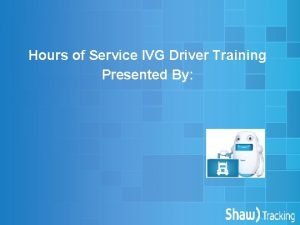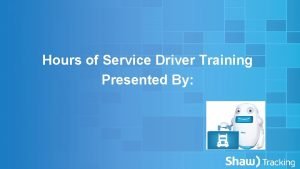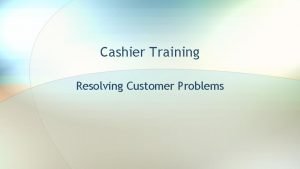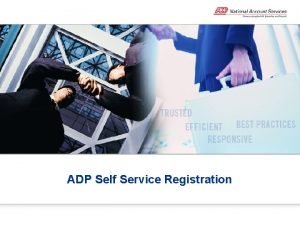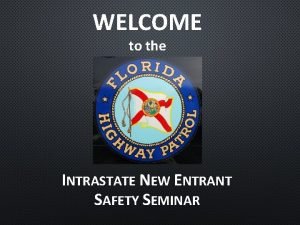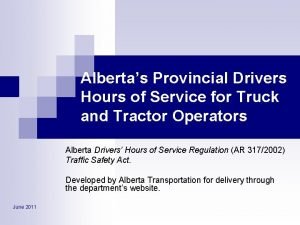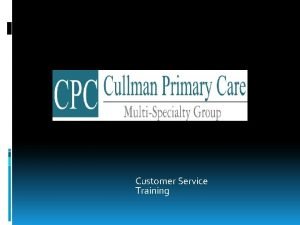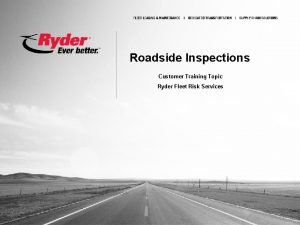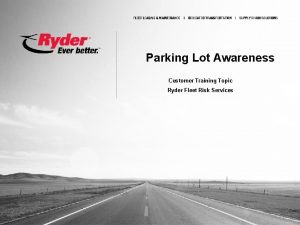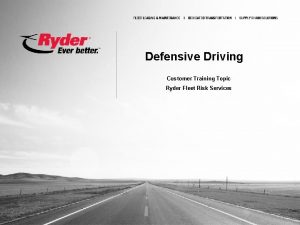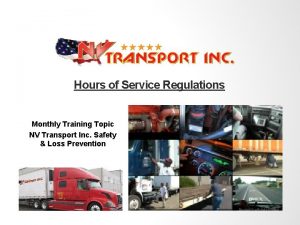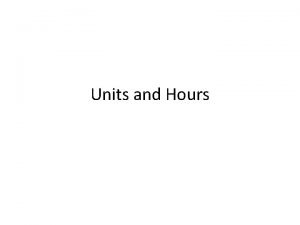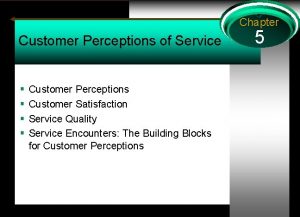Hours of Service Regulations Customer Training Topic Ryder

















- Slides: 17

Hours of Service Regulations Customer Training Topic Ryder Fleet Risk Services

What Are the Hours-of-Service Regulations? • Hours-of-Service regulations are found in Part 395 of the Federal Motor Carrier Safety Regulations. • The primary reason for hoursof-service regulations is safety. The goal of the regulations is to keep fatigued drivers off the road. • The regulations impose limits for when and how long a driver may drive. Proprietary and Confidential 2

Who Must Comply With the Hours-of-Service Regulations? • Motor Carrier and drivers of commercial motor vehicles are subject to the hours-of-service regulations. • Federal Motor Carrier Safety Regulations apply to motor carriers operating in interstate commerce. • States may impose similar hoursof service-regulations for intrastate operations Proprietary and Confidential 3

Definitions • Interstate - means goods have or will travel into or through another State or country. Even if your truck does not leave your State. • Intrastate - means goods and services stay within a single State. • On Duty Time - includes all time you are working or are required to be ready to work, for any employer. • Off Duty Time - only includes time when a driver is relieved of all duty and responsibility for performing work. • Adverse Driving Conditions - are considered to be unexpected adverse driving conditions that slow you down. • Driver’s Daily Log - is a written or electronic record to track the time a driver is driving, on-duty not driving, in a sleeper berth, or off duty. Proprietary and Confidential

Maximum Duty Limits • Hours-of service regulations focus on when and how long a driver is allowed to drive by placing specific limits on the amount of time a driver drives a commercial motor vehicle and how many total hours can be worked before the driver is no longer permitted to drive a commercial motor vehicle. Proprietary and Confidential • The three maximum duty limits are; ─ 14 hour duty limit; ─ 11 hour driving limit; ─ 60/70 hour duty limit. 5

60/70 Hour Duty Limit • The limits are based on a 7 day or 8 -day rolling period, not a set week, starting at a time specified by the motor carrier for the start of a 24 -hour period. • If the motor carrier does not operate vehicles every day of the week, drivers must follow the 60 -hours in 7 -days rule. • If the motor carrier does operate every day of the week, drivers may follow either the 60 -hour 7 -day rule or the 70 -hour 8 -day rule. Proprietary and Confidential 6

34 Hour Restart • Regulations allow a driver to “restart” their 60 or 70 -hour clock calculations. ─ After at least 34 consecutive hours off duty a driver will have the full 60 or 70 hours available again. • A motor carrier may not require a driver to use the 34 hour restart rule. It is optional. Proprietary and Confidential 7

Short Haul Exceptions – 150 Air Mile Driver • If an operator drives short distances in a vehicle that does not require a commercial driver’s license (CDL), the driver maybe able to use the non-CDL shorthaul exception. ─ A driver can only use this exception if they: − Drive a vehicle that does not require a CDL; and − Operates within a 150 air-mile radius of normal work reporting location ─ These criteria must also be met to use the non-CDL short-haul exception: − Driver must not drive for more than 11 hours following 10 consecutive hours off duty − Driver must not drive past the 14 th hour after coming on duty 5 days in any period of 7 consecutive days − Driver must not drive past the 16 th hour after coming on duty 2 days in any period of 7 consecutive days − Driver must not drive after being on duty 60 hours in any 7 consecutive days or 70 hours in any 8 consecutive days (unless the driver took 34 consecutive hours off to restart a 7/8 -day period) ─ Log books are not required, but time records must be kept for 6 months Proprietary and Confidential 8

Short Haul Exceptions – 100 Air Mile Driver • If an operator drives short distances in a truck that requires a commercial driver’s license (CDL), the driver may be able to make use of the 100 air mile short-haul exception. ─ These criteria must be met to use the exception: − Drivers must operate within a 100 air-mile radius of their normal work reporting location; − Drivers must start and return to the same work location and be released from duty within a 12 hour period − Drivers must not exceed 11 hours of driving time in a 12 hour work period; − Drivers are required to have 10 consecutive off-duty hours between each 12 hour work period; and − Driver must not drive after being on duty 60 hours in any 7 consecutive days or 70 hours in any 8 consecutive days (unless the driver took 34 consecutive hours off to restart a 7/8 -day period) ─ Log books are not required, but time records must be kept for 6 months Proprietary and Confidential 9

Short Haul Exceptions – 16 Hour Exception • If a driver returns to the work-reporting location and then goes home at the end of the workday, he or she may be able to use the 16 -hour short-haul exception. • This exception allows you to extend the 14 -consecutive-hour duty period once every 7 consecutive days. • In order to use this exception, the driver must do the following: ─ Return to the work reporting location each day ─ Be released from duty within 16 hours after coming on duty. ─ Must only use this exception once every 7 consecutive days (unless the driver took 34 consecutive hours off to restart a 7/8 -day period). Proprietary and Confidential 10

Sleeper Berth Provisions • Drivers may use an approved sleeper berth outlined in § 393. 76 to get their required off -duty time. • Driver’s may spend time in the sleeper berth to get some, or all, of the 10 consecutive hours of offduty time. • Driver’s may use the sleeper berth to extend the 14 -hour duty limit. Proprietary and Confidential 11

Sleeper Berth Provisions • Drivers may use an approved sleeper berth outlined in § 393. 76 to get their required off-duty time. • Driver’s may use the sleeper berth in a different way to get the “equivalent of at least 10 consecutive hours off duty. ” • One rest period must be no less than 8 hours and no more than 10. • A second rest period must be at least 2 hours and no more than 10 hours. • It does not matter which rest period the driver takes first. • Rest periods may be spent in sleeper berth, off duty, or a combination (it will count as part of the 14 hour duty limit unless the driver spends at least 8 hours in the sleeper berth) Proprietary and Confidential 12

Record Keeping • Driver’s Daily Log - is a written or electronic record to track the time a driver is driving, on-duty not driving, in a sleeper berth, or off duty. • Drivers must account for every day on their logs, even the days they are off duty. The log must cover all 24 hours of each day • Logs must include the 24 -hour graph grid, shown in § 395. 8, and contain specific information on each page. ─ Date ─ Total miles driving today ─ Truck or tractor and trailer number ─ Name of the carrier ─ Drivers signature in full ─ 24 -hour period starting time ─ Main office address ─ Remarks ─ Name of co-driver if applicable ─ Total hours ─ Shipping document number/name of shipper Proprietary and Confidential 13

Out of Service Drivers • Drivers can be placed out-ofservice for a number of reasons ─ Exceeding maximum driving time. ─ Exceeding maximum on duty status ─ Failing to have a log book ─ Failing to keep their log book current • Motor carriers have a duty to not require or permit a driver who has been placed out-of-service to drive. • Fines can be stiff for willful violations of the hours-of-service regulations. Proprietary and Confidential 14

Questions and Comments Proprietary and Confidential

Additional Information - Ryder Safety Services Rydersafetyservices. com offers solutions to help you operate safely and remain in compliance, whether you run vehicles, manage warehouses, hire drivers, or maintain your own fleet. § § Fleet safety equipment Compliance support services − − − § Driver Qualification Files Drug and Alcohol Testing Log Auditing Safety Training Materials at a discounted price − − JJ Keller Pro. Tread – On-line Driver Training And Much More! Proprietary and Confidential

Additional Information on Rules and Regulations This document is intended to be a guide on applicable rules and regulations. Although it may be used as a guide/reference for your training needs, this document is not intended to be used as the standard for FMCSA rules and regulations. Additional information can be found on the FMCSA website. The FMCSA website will contain the most accurate and upto-date information on any and all applicable rules and regulations. http: //www. fmcsa. dot. gov Proprietary and Confidential
 Will pair sb omnitracs
Will pair sb omnitracs Hours of service training
Hours of service training Ryder protread
Ryder protread Perbedaan customer relation dan customer service
Perbedaan customer relation dan customer service Achieveglobal
Achieveglobal Customer service training presentation
Customer service training presentation Telephone doctor customer service training
Telephone doctor customer service training Www telephonedoctor com
Www telephonedoctor com Customer service training program outline
Customer service training program outline Customer service and cashier training courses
Customer service and cashier training courses Sesserma
Sesserma Adpselfserviceportal
Adpselfserviceportal How to write a clincher sentence
How to write a clincher sentence Research problem example for students
Research problem example for students Florida intrastate hours of service rules
Florida intrastate hours of service rules 34 hour restart examples
34 hour restart examples Provincial hours of service alberta
Provincial hours of service alberta Dot and hours of service rules
Dot and hours of service rules
